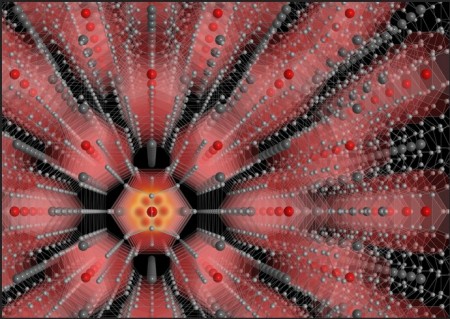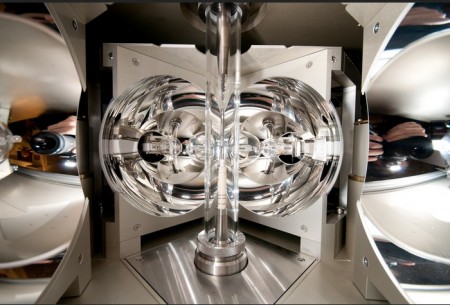Sep
26
A Big Improvement in Thermoelectric Material
September 26, 2013 | 2 Comments
The new molecular structure of the material has a very special layout in connection an astonishing new physical effect with tiny cages within the crystal structure enclosing cerium atoms.

Thermoelectric Clathrates with Cesium Artists Image. Image Credit, TU Vienna. Click image for the largest view.
The Austrian team reports a 50% enhancement of the thermopower compared with a rare-earth-free reference material in their paper published in Nature Materials. However, the press release has no mention of a figure of merit.
These trapped magnetic cerium atoms are constantly rattling the bars of their cage, and this banging about seems to be responsible for the material’s exceptionally favorable energy generating properties.
The technical term for the crystals is “Clathrates”, in which the hosted atoms are enclosed in cage-like spaces.
Professor Silke Bühler-Paschen at TU Vienna said, “These clathrates show remarkable thermal properties.” The exact behavior of the material depends on the interaction between the trapped atoms and the cage surrounding them. “We came up with the idea to trap cerium atoms, because their magnetic properties promised particularly interesting kinds of interaction,” explains Bühler-Paschen.
For a long time, this task seemed impossible. All earlier attempts to incorporate magnetic atoms such as the rare-earth metal cerium into the clathrate structures failed. But with the help of a sophisticated crystal growth technique in a mirror oven, Professor Andrey Prokofiev at TU Vienna has now succeeded in creating clathrates made of barium, silicon and gold, encapsulating single cerium atoms.

The mirror oven at TU Vienna where the novel thermoelectric clathrate material was created. Image Credit: TU Vienna. Click image for the largest view.
The thermoelectric properties of the novel material have been tested. Thermoelectrics work when they connect something hot with something cold: “The thermal motion of the electrons in the material depends on the temperature,” explains Bühler-Paschen. “On the hot side, there is more thermal motion than on the cold side, so the electrons diffuse towards the colder region. Therefore, a voltage is created between the two sides of the thermoelectric material.”
That’s a great layman’s explanation.
Experiments show that the cerium atoms increase the material’s thermopower by 50%, so a much higher voltage can be obtained. Furthermore, the thermal conductivity of clathrates is very low. This is also important, because otherwise the temperatures on either side would achieve equilibrium, and no voltage would remain.
“The reason for these remarkably good material properties seem to lie in a special kind of electron-electron correlation – the so-called Kondo effect,” Silke Bühler-Paschen believes. The electrons of the cerium atom are quantum mechanically linked to the atoms of the crystal. Actually, the Kondo effect is known from low temperature physics, close to absolute zero temperature. But surprisingly, these quantum mechanical correlations also play an important role in the novel clathrate materials, even at a temperature of hundreds of degrees Celsius.
“The rattling of the trapped cerium atoms becomes stronger as the temperature increases,” says Bühler-Paschen. “This rattling stabilizes the Kondo effect at high temperatures. We are observing the world’s hottest Kondo effect.”
The research team at TU Vienna will now try to achieve the effect with different kinds of clathrates. In order to make the material commercially more attractive, other metals, such as copper, could possibly substitute the expensive gold. Instead of cerium, a cheaper mixture of several rare-earth elements could be used. There are high hopes that such designer clathrates can be technologically applied in the future, to turn industrial waste heat into valuable electrical energy.
For an over all high efficiency of an energy transaction where heat is part of the yield thermoelectric materials are going to have a role in the future. The striking thing about the Austrian’s work is both the astonishing efficiency improvement and the operating temperatures amaze as well.
Comments
2 Comments so far


These are truly wonderful ideas in about blogging.
You have touched some pleasant points here.
Any way keep up wrinting.
I do not even know how I ended up right here, however I believed this submit was
once great. I do not know who you might be but definitely you are going to a well-known blogger in
case you aren’t already. Cheers!